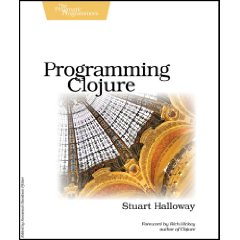Programming Clojure Review

When Stuart Halloway's Programming Clojure came out in May, I picked up a copy and have been reading through it and practicing with the Project Euler problems.
First off, it is a great book! Second off, it introduces a seriously interesting programming language.
Clojure is a Lisp dialect designed to run on Java Virtual Machine (JVM). This combination is what makes Clojure very powerful: you get the power of a mature virtual machine with access to any existing Java libraries, combined with the dynamic, functional style of Lisp. Imagine being able to continue to use the code and libraries you any others have spent years developing from a new programming environment.
Layering a language on top of the JVM is not a new concept. Jython, JRuby, Groovy, and others did it years ago. But to some extent, these languages serve as a mere face-lift to the verbose syntax of Java. These languages were ported or created for the JVM to harness the power of existing Java libraries and platforms, while providing a prettier language.
While Clojure does offer a new syntax, it has a much more fundamental contribution to the Java world: strong concurrency primitives. (It should be noted that Scala offers this benefit as well.)
Clojure takes a hard-line approach to the arch-enemy of concurrency: shared state. Clojure allows programmers to easily write concurrent programs that can execute on multiple processors or cores. This ability comes from several facets of Clojure:
- Immutable data
- Preferring "pure" functions by making the programmer explicitly state where shared state is accessed
- Multiple models for transactions and locks
Almost anyone who has experience writing threaded Java code, knows how difficult it is to ensure that multiple threads can execute in parallel without causing awful race conditions and subtle bugs. Luckily, Clojure addresses these shortcomings by using its own concurrency models.
Stuart's book begins by discussing the syntax of Clojure and demonstrates Clojure's ability to interact with regular Java classes. The book moves into the list-based world of Lisp with functional programming techniques, including lazy evaluation. The book then moves into advanced topics, including concurrency, macros, and Clojure's form of polymorphism, multimethods. The book concludes with a short chapter on testing Clojure code, working with SQL databases, and doing web development.
Through the book, we work on building an Ant replacement in Clojure. The most interesting take-away from this ongoing example is the use of actual Clojure code for the build DSL, removing the need for Ant's build.xml. The code-as-data concept is very elegant, resulting in a DSL that is very clear yet lacks XML's verbosity.
I also found the Snake game to be an excellent example of an application sharing state in a safe way using the Clojure transaction primitives.
The book gave me a great appreciation of the Lisp family of languages. The only wart that bothered me about Clojure was that it seems that at times the programmer must be too aware of the specific implementation of Clojure on the JVM. For instance, Clojure's recursion is at times hampered by the lack of Tail Call Optimization on the JVM. Because of this lack, the programmer must determine which work-around is most appropriate for his problem. Regardless, Clojure feels very clean and precise.
The book also clearly provides best practices and examples of idiomatic Clojure.
I look forward trying Clojure out in my projects. As I mentioned, I have been working through the Project Euler problems (my answers are definitely not ideal).
I would highly recommend the book to anyone who works in Java. I also believe the book is an excellent introduction to functional programming--I have read the Real World Haskell and Programming Erlang books with some difficultly, but Programming Clojure just clicked in my mind.